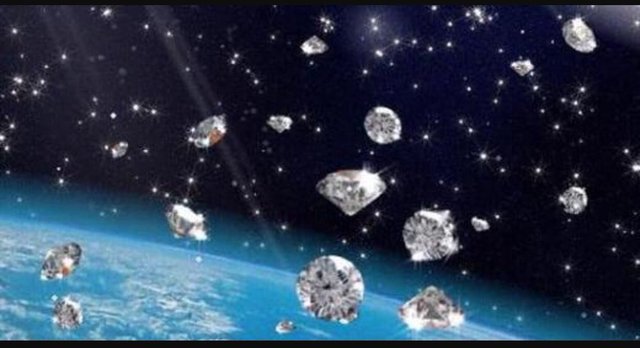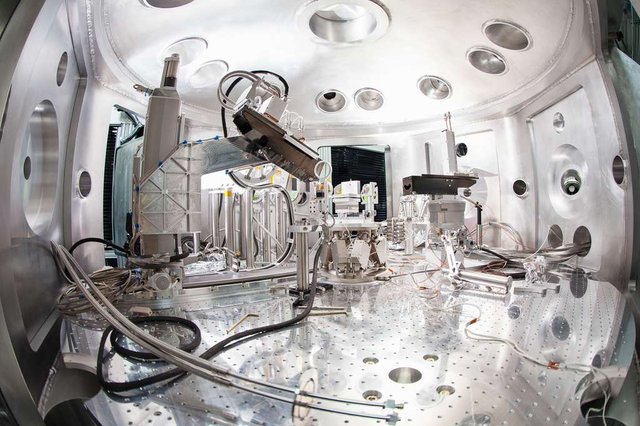In Neptune, it rains diamonds.
There would be plenty of diamond rains in the giant planets like Neptune or Uranus. This is confirmed by experiments carried out in the field of high pressure physics.

The summary :
Current models of the interior of Uranus and Neptune lead us to postulate that these planets are composed of three layers: an inner rock core, an intermediate layer of H2O, CH4 and NH3 ice , and one External layer of hydrogen-helium of solar composition.
For decades, experiments and calculations have suggested that in these giants, more than 10,000 kilometers deep, methane (CH4) underwent a transformation leading to the synthesis of diamonds.
A solid demonstration of this phenomenon has just been made by compressing a high-pressure and high-temperature polymer by means of a laser.
The current models of the internal structure of the giant planets of our Solar System are inheritors of those proposed by the American astrophysicist of German origin Rupert Wildt during the 1940s and 1950s. High-pressure physics and computer-based numerical simulations. These models also feed on purely theoretical work. Thus, in the early 1980s , US researchers came to the conclusion that the nuclei of giant planets, especially those of Neptune and Uranus , could contain colossal amounts of diamonds In solid form . The challenge is now to test this prediction in the laboratory, on Earth, using experiments involving compressed materials at very high pressures due to laser beams .
One of the last experiments in this field was conducted using a visible-emitting laser and the Matter in Extreme Conditions (MEC) instrument , associated with the free electron laser of the SLAC, the Linac Coherent Light Source (LCLS). The objective was to create intense pressures by means of shock waves caused by the impact of the laser pulses on a plastic material, in this case polystyrene (this consists of a mixture of hydrogen atoms And carbon which is found in very large quantities in giant planets, especially in the form of methane).

A view of the interior of the MEC, at SLAC, in Stanford, California . ©
Diamond rains weighing millions of carats :
The objective of the US and German researchers of the Helmholtz-Zentrum Dresden-Rossendorf wasn't simply to reproduce the conditions of pressure and temperature prevailing within the giant planets, but also to recreate the chemical reactions which produce, they wanted to observe these reactions live. This is why, parallel to the formation and propagation of the shock waves in the plastic, the latter has been subjected to laser pulses in the X-ray domain during a few femtoseconds. This allowed physicists to practice an X-ray diffraction technique called " femtosecond " "Which allows, in a way, to take snapshots of the reactions produced. This enabled them to establish that nanodiamonds are forming, but also to determine their size and to see them grow over time.
As the researchers explain in an article published in Nature , the results obtained are the first unambiguous observation of the formation at high pressures of diamonds in an environment with conditions similar to those prevailing inside the planet Neptune Pressures of approximately 150 gigapascals and temperatures of the order of 5,000 kelvins), and this in agreement with the theoretical predictions.
The diamonds synthesized during these experiments are nanometric in size. However, everything indicates that within giant planets like Uranus and Neptune, the diamonds formed are actually much larger, reaching weights of several million carats. Over thousands of years, these diamonds have to sink slowly into the layers of ice surrounding the rocky core of the giant planets. Ultimately, diamond layers are most likely to form around the heart of these giants, starting from diamond rains forming 10,000 kilometers below the surface of Uranus and Neptune.
These experiments aren't simply interesting from the point of view of high-pressure materials and astrophysics, whether they are the giant planets of the solar system or the exoplanets that resemble them and which are located elsewhere in the Milky Way. Indeed, this technique of synthesis of nanodiamonds could have interesting technological applications in the field of medicine or electronics; Such nanodiamonds are now produced using an explosion and are marketed. A laser synthesis route could thus offer more interesting prospects in terms of cost. This work could also have applications in the field of inertial controlled fusion, Where they are thermonuclear fuel balls containing deuterium and coated in plastic layers which are used.
Reference : nature.com